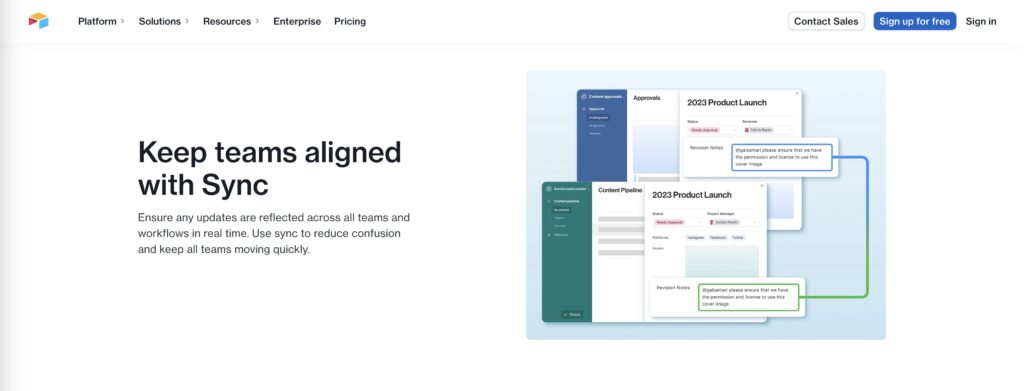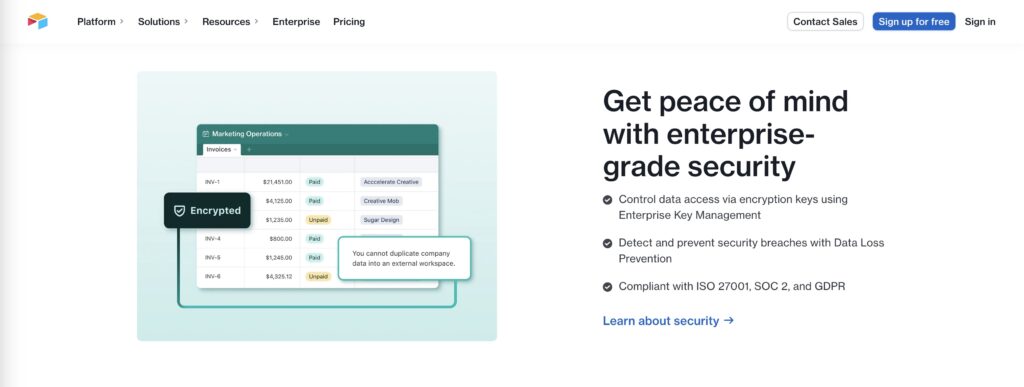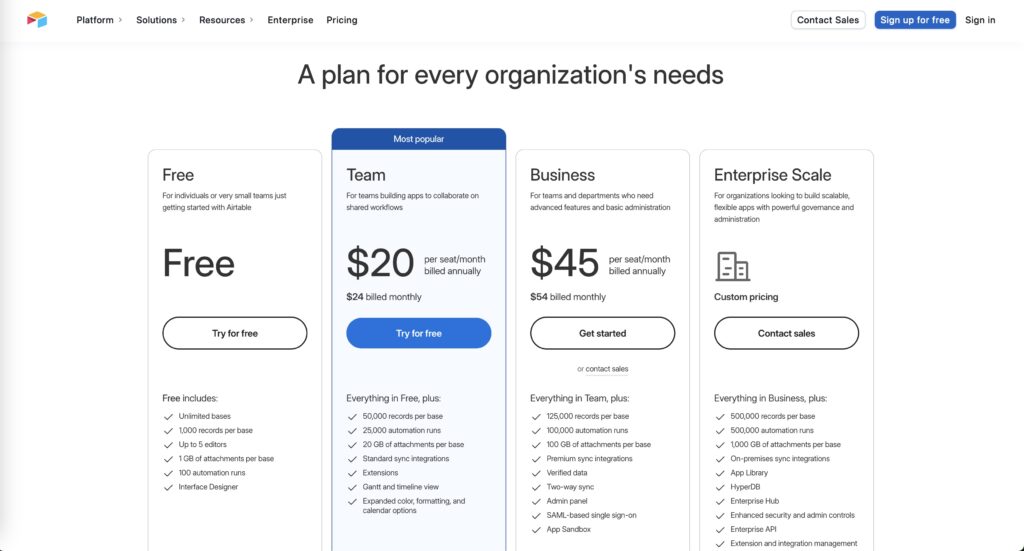“Choosing between Airtable vs Excel? This 2024 guide explores the features, pricing, and best use cases for each, helping you decide which is better suited for your business needs—whether you’re just starting or fully operational.”
TL;DR
Choosing between Airtable vs Excel depends largely on your business’s needs and stage of growth. Excel, the long-time leader, is unmatched for data analysis and complex calculations, making it perfect for established businesses with extensive data requirements. However, Airtable’s modern interface, database-like functionalities, and seamless collaboration capabilities make it a game-changer for small and mid-sized businesses, especially those that value flexibility and simplicity. This post covers the differences, highlights each tool’s strengths, and guides you on selecting the best tool for your business, whether you’re just starting out or fully operational.
Table of Contents
Introduction: Airtable vs Excel
Both Airtable vs Excel serve as essential tools for managing data, but they cater to slightly different needs. Airtable offers an exciting hybrid of a spreadsheet and a database, providing a fresh, visual approach to data management. Its drag-and-drop functionality, multiple view options (such as Kanban boards and galleries), and the ability to link related data make it a flexible and easy-to-use tool for businesses of all sizes.
On the other hand, Excel is a robust, time-tested spreadsheet application that has dominated the business world for decades. It’s particularly renowned for its powerful calculation capabilities, with advanced users able to perform deep data analysis through formulas, PivotTables, and VBA macros. Whether you’re generating financial forecasts or crunching large datasets, Excel remains unmatched in raw computational power.
Airtable, however, shines for users who need something more than just number-crunching. It allows businesses to create relational databases with minimal effort, making it suitable for managing content, projects, and customer relationships. Furthermore, its cloud-based infrastructure supports real-time collaboration, which Excel struggles to match, particularly in its desktop version.

User Experience and Interface: Airtable vs Excel
When you first open Airtable, its bright, clean interface invites you to get started without the overwhelming sight of endless rows and columns. Users love the ability to switch between various views (Grid, Calendar, Gallery, and Kanban) to manage their data visually, making it easy to track projects, assign tasks, or even manage inventories. This user-centric design makes Airtable especially appealing for small businesses or startups that need a lightweight tool without the steep learning curve.
In contrast, Excel’s interface is more traditional and function-heavy. Excel presents data in a dense grid format by default, which can appear intimidating to new users. However, for power users, this grid is a playground. Excel’s plethora of options—ranging from chart creation, conditional formatting, and macro programming—provide a comprehensive toolset that lets users fully control their data. The UI may not be as flashy, but its functionality runs deep, making it an indispensable tool for more complex tasks.
Despite the steep learning curve for newcomers, Excel rewards experienced users with extensive customization and power. Airtable offers a smoother, more intuitive experience that doesn’t require technical expertise, making it a better fit for non-specialist teams or individuals who value simplicity.
Collaboration Features: Airtable vs Excel
In a world where remote work and real-time collaboration are more critical than ever, Airtable vs Excel present vastly different experiences. Airtable is built around cloud collaboration. Its cloud-native platform ensures that team members can work on the same project in real-time, with changes reflected immediately for all users. Comments can be added to individual records, files can be uploaded, and collaborators can be tagged—all within the same platform. Additionally, Airtable’s permissions system allows you to control who has access to different parts of your workspace, making it suitable for teams with varied responsibilities.

Excel also offers cloud-based collaboration through Excel Online, but it’s not as seamless or integrated as Airtable’s real-time collaboration. Excel Online lacks some of the features available in the desktop version, and while you can share workbooks and collaborate simultaneously, the experience doesn’t feel as fluid. The desktop version of Excel still reigns supreme when it comes to local data manipulation and advanced tasks but falls short in real-time collaboration compared to Airtable.
For teams that need to collaborate on projects, manage tasks, and update records frequently, Airtable is the better tool. However, for more individual-focused work or heavy-duty data manipulation, Excel remains a solid choice.
Customization and Flexibility: Airtable vs Excel
Customization is a key factor when choosing between Airtable vs Excel. Airtable’s flexibility is one of its most significant advantages. Users can customize each field type—text, numbers, attachments, and more—and easily rearrange data without needing to delve into complex formulas. Additionally, the ability to link different tables and create relationships between them gives users the freedom to model data in a way that makes sense for their business.
For example, if you’re a content manager, you can link an editorial calendar to a database of authors and projects, making it easy to track who’s working on what, set deadlines, and monitor progress. Moreover, Airtable’s customizable templates allow businesses to set up workflows quickly without the need for extensive technical skills. Templates are available for everything from marketing to HR, making it easier for businesses to get started.

Excel, while not as immediately flexible in terms of layout and design, offers advanced customization capabilities through formulas, VBA scripts, and macros. If your business requires detailed calculations, Excel’s flexibility through its extensive formula library allows you to manipulate data in highly specific ways. It’s a favorite for financial professionals, engineers, and data analysts who need to model complex datasets and create custom dashboards or reports.

For non-technical teams or businesses that need a more visual and relational approach to data, Airtable is likely the better fit. For businesses that need to perform complex calculations or financial modeling, Excel’s advanced features offer unparalleled flexibility.
Data Management and Storage Capabilities
When it comes to managing large datasets and organizing information, Airtable vs Excel differ in their approach. Airtable excels at organizing data with relational database-like features. You can link tables, which is ideal for teams that need to track interconnected data—such as projects, clients, and resources—across multiple departments. The relational nature of Airtable also means that it can scale with your business as your data becomes more complex. For instance, marketing teams can track campaigns, content, and metrics in separate tables but link them together for deeper insights.

Excel, on the other hand, shines when it comes to handling large datasets and performing data analysis. Excel can process vast amounts of data, and with features like Power Query and PivotTables, it’s a go-to tool for businesses needing to handle massive spreadsheets, conduct in-depth data analysis, and create detailed reports. Excel’s storage capacity and ability to manage structured and unstructured data make it an essential tool for businesses that handle large volumes of data, like finance and logistics.

While Airtable is perfect for smaller datasets that need relational capabilities and user-friendly visualizations, Excel is the tool to choose if your business needs to handle and process large amounts of information efficiently.
Advanced Automation and Integrations: Airtable vs Excel
Automation and integrations are two key areas where Airtable vs Excel differ greatly. Airtable excels in this department with its built-in automation tools. You can set up workflows to automate repetitive tasks such as sending notifications, generating reports, or creating new records when certain conditions are met. This automation capability is particularly useful for businesses looking to improve productivity by reducing manual processes. Airtable integrates with over 1,000 apps, including popular business tools like Slack, Google Drive, Trello, and Salesforce. These integrations allow businesses to create powerful workflows without the need for custom code.

Excel also offers automation through VBA (Visual Basic for Applications), which allows users to automate complex tasks by writing scripts. While VBA is incredibly powerful, it requires a higher level of technical expertise. For businesses that can leverage this, Excel’s automation potential is limitless. Macros, for example, can automate repetitive tasks in Excel, saving businesses significant time when dealing with large datasets or recurring reports.
For businesses seeking easy-to-use automation without coding knowledge, Airtable wins out with its simple interface and pre-built integrations. However, for those who require more advanced, custom automation, Excel’s VBA capabilities are unparalleled.
Mobile Access and App Features
Mobile access is becoming increasingly important for businesses that operate on the go, and both Airtable vs Excel provide mobile apps for users. Airtable’s mobile app is well-designed and offers much of the same functionality as its desktop version. Users can view, edit, and create records directly from their mobile devices, making it easy to update projects or add new information while away from the office.
Excel, available as part of Microsoft’s Office suite, also has a mobile app, which is surprisingly powerful given its complexity. Users can open and edit spreadsheets, use basic formulas, and even create charts directly from their mobile devices. However, the more advanced features of Excel (like PivotTables or complex macros) are difficult to manage on a smaller screen.

For most users, Airtable’s mobile app offers a more streamlined experience that focuses on simplicity and collaboration. If your business requires you to access complex spreadsheets on the go, Excel’s mobile app still provides a solid solution.
Security and Compliance: Airtable vs Excel
Security is a top concern for businesses, and in the Airtable vs Excel comparison, both platforms offer strong security features, though they differ in approach. Airtable provides end-to-end encryption for data in transit and at rest. It also offers granular permission settings, so administrators can control who has access to specific bases, tables, or views. For businesses in industries with stringent compliance requirements, Airtable offers features like two-factor authentication (2FA) and SSO (Single Sign-On) to enhance security.

Excel, as part of the Microsoft 365 suite, benefits from Microsoft’s robust security infrastructure. It includes advanced threat protection, data loss prevention, and encryption. Excel also allows for password protection and permissions on individual workbooks or worksheets, making it suitable for businesses handling sensitive data. Additionally, for industries that require compliance with GDPR, HIPAA, or other regulations, Microsoft’s security protocols provide peace of mind.
For businesses that prioritize security and compliance, both Airtable vs Excel offer strong solutions. Airtable’s user-friendly security controls are great for smaller teams, while Excel’s integration with the Microsoft security ecosystem makes it ideal for larger enterprises.
Pricing Models: Airtable vs Excel
When choosing between Airtable vs Excel, pricing is a critical factor for most businesses. Airtable’s free plan is generous, allowing for unlimited bases but with certain restrictions like limited records per base and no advanced features. As businesses scale, they’ll likely need to upgrade to one of Airtable’s paid plans, which start at $10 per user per month. This gives access to features like advanced reporting, automations, and more significant storage limits, making it a good choice for growing teams.

Excel, on the other hand, comes as part of the Microsoft 365 suite, with plans starting at $5 per user per month for business essentials. This makes it more affordable for businesses already using other Microsoft tools, as Excel is bundled with apps like Word, PowerPoint, and OneDrive. For companies looking for a full office productivity suite, Excel’s inclusion in Microsoft 365 is a cost-effective option.

Small businesses or startups may find Airtable’s free plan sufficient at the beginning, while larger organizations that already use Microsoft 365 might prefer Excel’s affordability and bundling with other tools.
Best Fit for Business Levels
Just Starting: Airtable
For new businesses just getting off the ground, Airtable offers the best balance of ease of use, flexibility, and collaboration. Its visual interface, drag-and-drop capabilities, and ability to integrate with other popular business tools make it ideal for small teams.
Growing Business: Airtable and Excel
As your business grows, your data management needs may evolve. At this stage, both Airtable vs Excel have their strengths. Airtable’s real-time collaboration, workflow automations, and integrations continue to be valuable, especially for growing teams. However, Excel’s data analysis capabilities and financial modeling tools start to come into play, particularly for businesses managing larger datasets or complex financial reports.
Fully Operational Business: Excel
For fully operational businesses that require advanced data manipulation and extensive reporting, Excel is the go-to tool. Its depth of functionality, vast formula library, and ability to manage large datasets make it the perfect fit for enterprises that need powerful data processing capabilities.
Future Trends: Airtable vs Excel
Looking ahead, both Airtable vs Excel are positioned to continue evolving. Airtable is likely to keep expanding its automation capabilities and integrations, making it even more accessible to businesses looking to streamline their workflows. The rise of low-code and no-code tools is also a trend that Airtable could leverage, enabling users to build more customized solutions without needing technical expertise.
Excel, while well-established, is also evolving. Microsoft’s focus on AI and machine learning means that Excel’s future may include more advanced predictive analytics and automated data insights. Additionally, deeper integration with Microsoft’s Power BI platform is expected, further enhancing Excel’s role in business intelligence and data visualization.
As businesses become more data-driven, the ability to automate workflows, analyze data, and integrate with other tools will be critical. Both Airtable vs Excel will play a role in shaping the future of data management, each catering to different types of businesses with distinct needs.
3 Alternatives to Airtable and Excel
If neither Airtable nor Excel seems like the right fit for your business, here are three alternatives to consider:
- Google Sheets
Google Sheets is a popular alternative that combines cloud-based collaboration with basic spreadsheet functions. It’s free for individuals and small teams, and integrates seamlessly with Google Workspace tools like Docs and Drive. - Smartsheet
Smartsheet is a powerful tool for project management and task tracking, blending the flexibility of a spreadsheet with the functionality of a project management app. It’s ideal for larger organizations needing to manage resources and timelines with powerful reporting features. - Zoho Sheet
Zoho Sheet is part of the Zoho suite and offers a good balance between collaboration and data analysis. It’s a cloud-based solution that integrates well with other Zoho tools, making it an excellent choice for businesses already using Zoho’s ecosystem.




